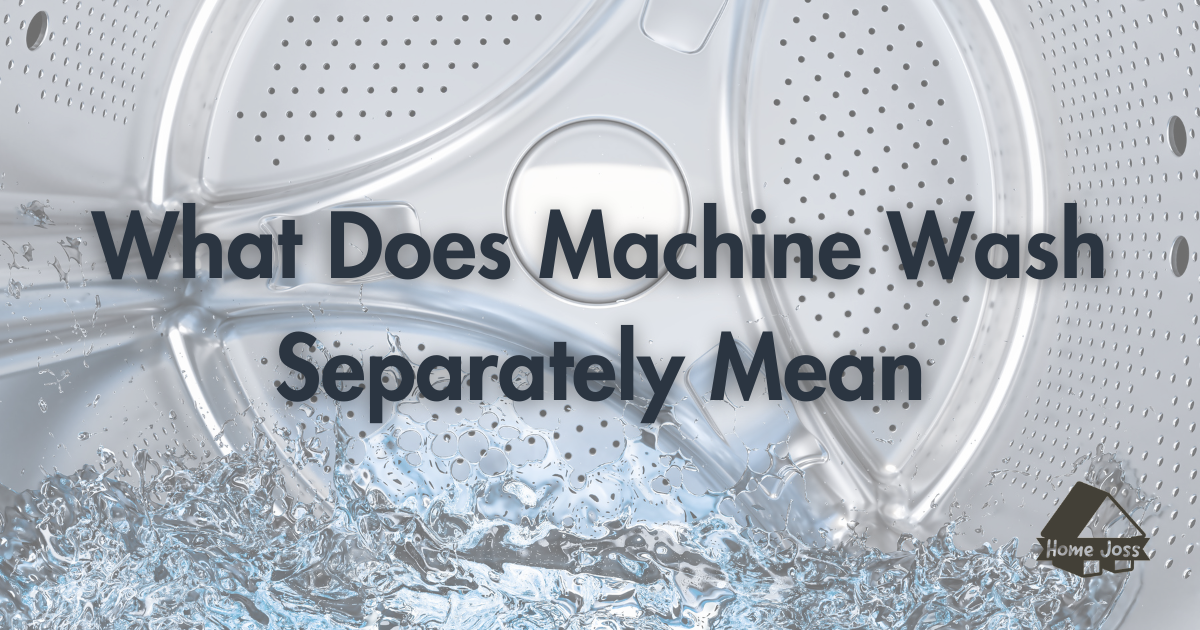Machine wash instructions and laundry care symbols play a crucial role in understanding what does machine wash separately mean and how to properly care for your clothes. It is important to avoid laundry damage and preserve the quality of your clothing.
The term “wash separately” refers to washing a specific piece of clothing on its own, separate from other items. This is often indicated by a tag with the instructions.
Certain fabrics, such as delicate, colorfast, or bleed-prone materials, must be washed separately to prevent color transfer and damage. Sorting clothes by color and fabric weight is recommended to ensure a successful wash. Pre-treating stains and following care instructions for temperature, detergent amount, and drying method are also essential for proper laundry care.
Washing clothes separately is crucial to avoid laundry mishaps and maintain the longevity of garments. By understanding the meaning of machine wash separately and following the appropriate washing instructions, you can ensure that your clothes stay in great condition.
Take the time to read the laundry care symbols and always follow the manufacturer’s recommendations for the best results. With proper care, your clothes will look and feel their best, lasting longer and remaining in excellent shape.
The Significance of Washing Clothes Separately

Washing clothes separately is a vital step in maintaining their quality and preventing mishaps during the laundry process. When garments are washed together, the risk of color transfer increases, especially when dealing with items that are delicate, colorfast, or prone to bleeding. To avoid any unwanted color mishaps, it is essential to sort clothes by color and fabric weight.
A table can be created to provide a visual representation of how to separate clothes based on color and fabric weight. This table can consist of two columns: one for color categories (such as whites, lights, darks, and brights) and another for fabric weight categories (such as lightweight, medium-weight, and heavy).
By following this sorting method, clothing can be washed separately, ensuring that colors do not bleed onto other garments and that delicate fabrics are treated with the appropriate care.
| Color Category | Fabric Weight Category |
|---|---|
| Whites | Lightweight |
| Lights | Medium-Weight |
| Darks | Heavy |
| Brights |
Additionally, it is important to read and follow the specific care instructions provided by the clothing manufacturer. These instructions can be found on the garment’s tag and may include guidance on temperature, detergent amount, and drying method.
By following these instructions, you can effectively pre-treat stains and ensure that your clothes are being washed in the best possible way to maintain their quality and appearance.
By washing clothes separately, you can avoid laundry mishaps such as color bleeding, fabric damage, and shrinkage. This not only preserves the longevity of your garments but also saves you from the frustration and expense of having to replace them.
Remember to pay attention to laundry care symbols on clothing labels, as they provide important information on how to handle and wash specific garments. Taking the time to wash your clothes separately and following care instructions will help keep your wardrobe looking its best, wash after wash.
How Important is Washing Separately (Video)
In the video ‘How Important is Washing Separately,’ learn about the practical reasons behind the advice to separate your laundry. It explains what can happen to your clothes if you ignore this guidance and provides real examples and data on the topic.
If you’ve ever mixed darks and lights or wondered why it’s advised against, this video offers clear, straightforward answers.
Pre-Treating Stains and Following Care Instructions
Pre-treating stains and carefully following laundry care instructions are essential for achieving clean and well-maintained garments. Whether it’s a stubborn coffee spill or a grass stain from an outdoor adventure, treating stains promptly can significantly increase the chances of successful removal.
Here are some steps to effectively pre-treat stains:
- Gently blot the stain with a clean cloth or paper towel to absorb any excess liquid.
- Check the clothing label for specific instructions on stain removal and follow them accordingly.
- If no specific instructions are provided, you can use common stain remover products or household items like dish soap or hydrogen peroxide.
- Before applying any stain remover, test it on a small, inconspicuous area of the garment to ensure it doesn’t cause any damage or discoloration.
- Apply the stain remover directly to the stain, then gently rub or dab the fabric to work the product into the fibers.
- Allow the stain remover to sit for the recommended time, usually 5-10 minutes, to break down the stain.
- Afterward, wash the garment according to the care instructions. Be sure to check the recommended water temperature, detergent amount, and any other specific instructions.
By pre-treating stains in this manner, you can effectively tackle common stains and improve the overall cleanliness of your garments. It is important to note that some stains may require professional cleaning, so if you are unsure or the stain persists after your attempts, it’s best to consult a professional cleaner.
Proper Washing Techniques
In addition to pre-treating stains, following proper washing techniques is crucial for maintaining the quality of your clothes. Here are some key guidelines for a successful wash:
- Sort your clothes by color and fabric weight to prevent color bleeding and ensure even washing.
- Use the recommended water temperature indicated on the garment label. Hot water is ideal for white or heavily soiled items, while cold water is suitable for most colors.
- Choose the right detergent and measure the appropriate amount, as using too much can leave residue, and using too little may not provide sufficient cleaning power.
- Select the proper cycle on your washing machine to accommodate the fabric type and level of dirtiness.
- When drying, follow the care instructions to determine if air drying, using a clothesline, or machine drying on low heat or delicate setting is recommended.
By adhering to these washing instructions, you can help prolong the life of your garments and keep them looking their best. Remember, each piece of clothing may have unique care requirements, so it’s always best to check the label and follow any additional instructions provided by the manufacturer.
| Water Temperature | Washing Cycle | Drying Method |
|---|---|---|
| Hot Water (approx. 130°F/55°C) | White or Heavily Soiled Items | Machine Drying on High Heat |
| Warm Water (approx. 90°F/32°C) | Colors or Moderately Soiled Items | Machine Drying on Medium Heat |
| Cold Water (approx. 60°F/15°C) | Delicate Fabrics or Lightly Soiled Items | Air Drying or Machine Drying on Low Heat |
Avoiding Laundry Mishaps and Maintaining Garments
By practicing proper clothing maintenance and understanding laundry care symbols, you can avoid laundry mishaps and ensure the longevity of your favorite garments. It’s important to take proactive steps to protect your clothes and prevent accidental damage during washing.
Here are some key tips and tricks to help you maintain your garments.
Sort Clothes by Color and Fabric Weight
Sorting your clothes before washing is crucial to prevent color transfer and fabric damage. Separate light-colored items from darker ones to avoid any color bleeding. Additionally, sort your clothes based on fabric weight.
Washing heavy items like jeans with delicate fabrics can cause unnecessary friction, leading to damage. By taking the time to sort your clothes, you’ll avoid potential mishaps and keep your garments in excellent condition.
Pre-Treat Stains
Before tossing your clothes in the washing machine, it’s important to pre-treat any stains. This ensures that the stains will be effectively removed during the wash. Follow the instructions on your stain remover product and apply it directly to the stained area.
Let it sit for the recommended amount of time before laundering as usual. By pre-treating stains, you increase the chances of successfully removing them, thus maintaining the pristine appearance of your garments.
Follow Care Instructions
Each garment comes with specific care instructions provided by the manufacturer. It is essential to read and follow these instructions to ensure proper laundry care. Pay attention to the recommended washing temperature, detergent amount, and drying method. By adhering to the care instructions, you can avoid damaging your clothes and extend their lifespan.
With proper clothing maintenance and attention to laundry care symbols, you can effectively prevent laundry mishaps and preserve the quality of your garments. By sorting your clothes, pre-treating stains, and following care instructions, you’ll keep your favorite pieces looking their best for years to come.
| Clothing Maintenance Tips |
|---|
| Sort clothes by color and fabric weight. |
| Pre-treat stains before washing. |
| Follow care instructions provided by the manufacturer. |
FAQ
What does “machine wash separately” mean?
“Machine wash separately” refers to washing a specific piece of clothing on its own, separate from other items. This is often indicated by a tag with the instructions.
Why do certain fabrics need to be washed separately?
Certain fabrics, such as delicate, colorfast, or bleed-prone materials, must be washed separately to prevent color transfer and damage.
How should I sort clothes for washing separately?
Sorting clothes by color and fabric weight is recommended to ensure a successful wash.
How should I pre-treat stains and follow care instructions?
Pre-treating stains and following care instructions for temperature, detergent amount, and drying method are essential for proper laundry care.
Why is washing clothes separately important?
Washing clothes separately is crucial to avoid laundry mishaps and maintain the longevity of garments.
Understanding what does machine wash separately mean is the key to preserving the quality of your clothes. By following proper laundry care symbols and washing instructions, you can ensure the longevity and cleanliness of your garments.
When a garment requires machine washing separately, it is essential to wash it on its own, separate from other items. This is often indicated by a tag with specific instructions. Certain fabrics, such as delicate, colorfast, or bleed-prone materials, must be washed separately to prevent color transfer and damage.
To successfully wash clothes separately, it is recommended to sort them by color and fabric weight. This will help prevent color bleeding and ensure a thorough and efficient wash. Additionally, pre-treating stains and following care instructions for temperature, detergent amount, and drying method are crucial steps for proper laundry care.
By adhering to these guidelines and understanding the importance of washing clothes separately, you can avoid laundry mishaps and maintain the longevity of your garments.
Regular inspections for any damage or wear and tear, as well as paying attention to laundry care symbols and washing instructions, will further contribute to the maintenance of your clothing.






